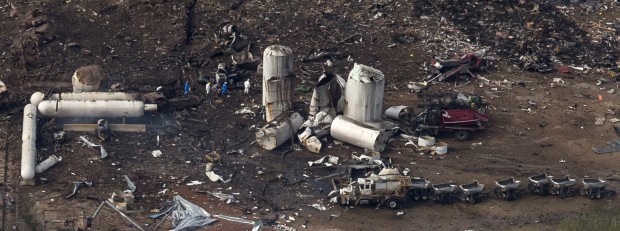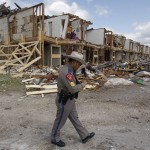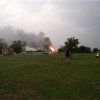Background

Photo by REUTERS/Adrees Latif
An aerial view shows investigators walking through the aftermath of a massive explosion at a fertilizer plant in the town of West, near Waco, Texas April 18, 2013.
On April 17, 2013, an explosion at the West Fertilizer Company in West, Texas killed 15 people, injured at least 200 more and damaged 350 homes. The explosion occurred after a fire broke out in the plant. Investigators from the Texas Department of Insurance and State Fire Marshall’s Office concluded ammonium nitrate was the cause of the explosion. The Investigators also said the fire started in the company’s fertilizer and seed building, but have not yet found the cause of the fire. The majority of those killed in the blast were volunteer firefighters or first responders on their way to help with the fire.
Federal and state authorities announced in May 2013 that they could not determine what started the fire that caused the plant’s store of ammonium nitrate to explode. Investigators said that the fire could have been sparked by a faulty golf cart, an electrical system malfunction, or an arsonist.
Investigators have ruled out weather, natural causes, anhydrous ammonia, the railcar containing ammonium nitrate or a fire within the ammonium nitrate bin as causes for the fire. Investigators also said water used in the firefight did not cause or contribute to the explosion.
The investigation into the deaths of the first responders, as well as into the origin and cause of the fire is expected to continue for a few more weeks.
The West Fertilizer plant had been open and operating since 1962. The company was permitted and regulated by several state and federal agencies, including OSHA, EPA and TCEQ.
Records from the Texas Department of State Health Services show the plant had as much as 270 tons of ammonium nitrate (which can be explosive) on site in 2012. Complaints of an ammonia smell led the TCEQ to inspect the plant in 2006. That year, the EPA fined the company for not having a risk management plan; a later plan filed by the company in 2011 did not mention that ammonium nitrate was stored at the facility.
The plant’s proximity to a nursing home and middle school has raised concerns over zoning. Many schoolchildren will be finishing out the school year in Waco after the West Intermediate School was seriously damaged, along with West High School, which was also impaired. Both schools will have to be torn down and rebuilt.
At least 74 other sites in Texas report large stores of potentially explosive ammonium nitrate. Some 20,000 people live within a half-mile of those sites, according to the Dallas Morning News.
The blast blew out windows miles away and even registered as an earthquake. Investigators said it left a crater 10 feet deep and nearly 100 feet wide.
The Federal Emergency Management Agency (FEMA) has denied disaster relief funding to help rebuild West, although the agency has supplied individual residents with emergency funds.



